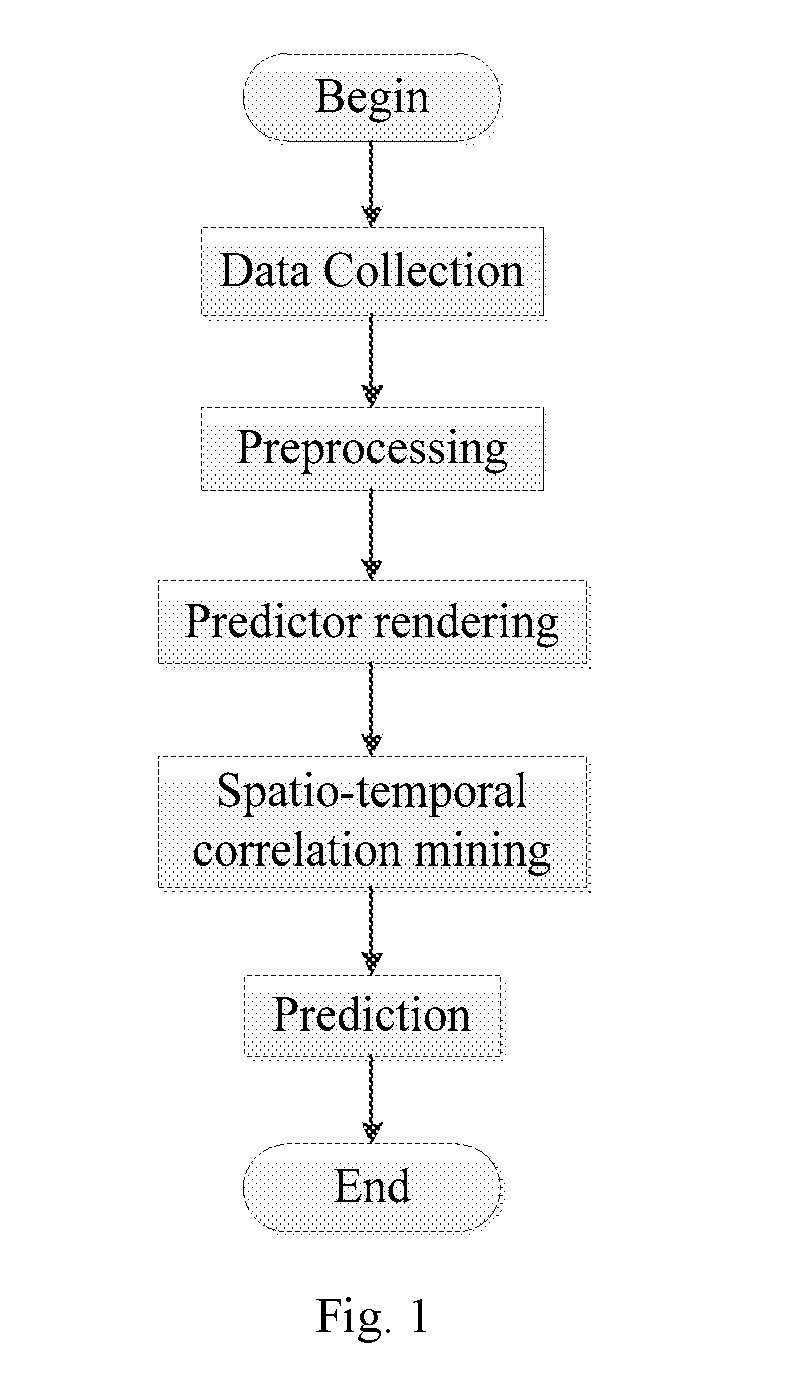Method for traffic flow prediction based on spatio-temporal correlation mining
a technology of spatiotemporal correlation and traffic flow, applied in the field of traffic flow prediction, can solve the problems that variable selection based on human experience cannot be generalized to be applicable to large-scale road networks, and its performance is subject to the quality of historical data
- Summary
- Abstract
- Description
- Claims
- Application Information
AI Technical Summary
Benefits of technology
Problems solved by technology
Method used
Image
Examples
embodiment 1
[0031](Step 1) Data Collection: By means of the sensors distributed at the nodes all over the road network, the traffic volume data are collected per 30 seconds to record the data from every sensor in the whole road network, which is in the form of a matrix as follows:
S=[s11s12…s1Ms21s22…s2M⋮⋮⋮⋮sN1sN2…sNM]
where M is the number of all the sensors in the road network, N is the length of the time series with 30 seconds as the time unit, and sij is the traffic volume of 30 seconds of time i archived from sensor j.
[0032](Step 2) Preprocessing: Adjust the time scale of the raw data from the time unit of 30 seconds to 10 minutes per time interval. Correspondingly, the data are reformatted into a matrix as follows:
V^=[v11v12…v1Mv21v22…v2M⋮⋮⋮⋮vn1vn2…vnM]
where
vij=∑k=120s(i-1)×20+kjandn=N20.
Then, compute the standard deviation of every column in {circumflex over (V)} and let std(j) represent the standard deviation of the jth column. If std(j)m×n, where m is the number of the sensors involved i...
embodiment 2
[0037]Except for step 4, the other steps are the same as the corresponding ones of embodiment 1.
[0038](Step 4) After normalize every column of V and νj=[ντ+1j, ντ+2j, . . . , ντ+nj]T as follows, we obtain
V_=[v11∑i=1n(vi1)2v12∑i=1n(vi2)2⋯v1m∑i=1n(vim)2v21∑i=1n(vi1)2v22∑i=1n(vi2)2⋯v2m∑i=1n(vim)2⋮⋮⋮⋮vn1∑i=1n(vi1)2vn2∑i=1n(vi2)2⋯vnm∑i=1n(vim)2]andv_j= [vτ+1j∑i=1n(vτ+ij)2vτ+2j∑i=1n(vτ+ij)2⋮vτ+nj∑i=1n(vτ+ij)2];
[0039]The objective to be optimized by sparser representation is:
w^j=argminwj||wj||1subjectto||Vwj-vj||22=∑i=1n||Viwj-vij||2≤ɛ0
where ∥wj∥1 is the l1 norm of wj to indicate the sum of the absolute value of every element in wj, and ε0 a predefined threshold to confine the prediction error ∥Vwj−νj∥2, which means the l2 norm of Vwj−νj, that is, the square root of the sum of the square of every element in the vector. The objective to be optimized in the above expression is equal to the alternative unconstraint one after applying Lagrange multiplier λ:
w^j=argminwj{λ||wj||1+12||V_wj-v_j||2...
embodiment 3
[0040]Except for step 5, the other steps are the same as the corresponding ones in embodiment 2.
[0041](Step 5) The prediction model is Vector Autoregressive (VAR) model [Chandra, S. R., Al-Deek, H., 2009. Predictions of freeway traffic speeds and volumes using vector autoregressive models. Journal of Intelligent Transportation Systems 13 (2), 53-72], computed as follows:
vtj=∑d=1p∑i=1mwijψijBdvti+utj
where B means time delay operation, namely, Bdνt=νt−d. If sensor i is correlated to sensor j, that is, the ith element in the vector ŵj solved from step 4 is not zero, then, let Ψij=1. On the contrary, let Ψij=0. utj denotes independent normal Gaussian noise. wij is the parameter to be optimized, which can be approached by using the maximum likelihood method based training.
PUM
 Login to View More
Login to View More Abstract
Description
Claims
Application Information
 Login to View More
Login to View More - R&D
- Intellectual Property
- Life Sciences
- Materials
- Tech Scout
- Unparalleled Data Quality
- Higher Quality Content
- 60% Fewer Hallucinations
Browse by: Latest US Patents, China's latest patents, Technical Efficacy Thesaurus, Application Domain, Technology Topic, Popular Technical Reports.
© 2025 PatSnap. All rights reserved.Legal|Privacy policy|Modern Slavery Act Transparency Statement|Sitemap|About US| Contact US: help@patsnap.com



